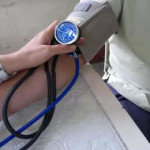How Does A Blood Pressure Cuff Work?
Typically, sphygmomanometers (the medical device that is commonly used to measure blood pressure) come with the cuff. The cuff is needed to make sure you get the accurate blood pressure readings. Without it, a sphygmomanometer will not work accurately. Therefore, it’s important for you to choose the right size of cuff so thus you can use it properly.
As well we know, you will find two numbers of pressures (generally giving in mm Hg) when you measure your blood pressure with sphygmomanometers. They are systolic and diastolic pressure.
For instance, the normal blood pressure level is about 120 /80 mm Hg – 120 points to the systolic pressure, and 80 for diastolic pressure. While systolic pressure is the force of the blood inside the arteries when your heart beats or pumps the blood, diastolic pressure points to the force of the blood in the blood vessels when your heart is relaxed (between beats).
When you put the cuff of sphygmomanometer on your upper arm and then you /your doctor inflates or pumps it up, this will affect the flow of the blood inside arteries around your upper arm. With the appropriate pressure exerted by the cuff, the blood that flow through those blood vessels can be blocked temporarily.
 As the exerted pressure is released /deflated slowly, the blocked blood flow will start to flow and then you or your doctor can notice the sound of your blood flow through stethoscope (if you /your doctor use a manual blood pressure monitor).
As the exerted pressure is released /deflated slowly, the blocked blood flow will start to flow and then you or your doctor can notice the sound of your blood flow through stethoscope (if you /your doctor use a manual blood pressure monitor).
Once you hear the first sound of the pulse beat – read the reading on the gauge and then note it is your systolic pressure. As the cuff continuously deflates, the pulse beat that you hear goes slower until it disappears. And then as soon as you cannot hear any heart pulse beat in stethoscope – see the reading on the gauge and mark it as your diastolic pressure.
Unlike in manual /analog monitor, the use of digital blood pressure monitor is much more practical. Both manual and digital monitor use the cuff. But in digital monitor, there is no stethoscope – therefore, you don’t have to manually read the gauge.
Just use the cuff, then inflate and deflate it properly, the result of your systolic and diastolic pressure will be displayed digitally. For more detailed information on how to use both manual and digital monitors, and how to find the accurate blood pressure readings, visit this previous section!
Typically, the cuff is designed with flexible air bladder that links to a bulb pump. To read to the systolic and diastolic pressure during the test, the air bladder is also connected with a pressure sensor that links to the numbered gauge readings.
In order to inflate the cuff, you need to squeeze the bulb by squeezing the tester. This can cut off the blood flow to your arm. And stopping pressure to the arm can be used for the pressure sensor to accurately record and print the pressure when it returns.
Since the cuff is very crucial to provide accurate reading of your systolic and diastolic pressures, you need to use it properly. Therefore, it’s important to choose the appropriate size of cuff – as noted before. Make sure it meets to the size of your upper arm. Both oversize and undersize has an effect to the result of the test.
As mentioned before, stethoscope is needed in manual monitors to find systolic and diastolic pressure. But in digital monitors, stethoscope is typically not needed. The result of the test will be automatically displayed after the exertion released by the cuff deflates completely.
In general, the working principle of digital monitor is based on a method called oscillometric.



